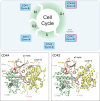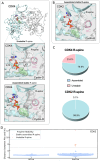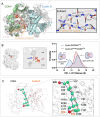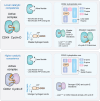CDK2 and CDK4: Cell Cycle Functions Evolve Distinct, Catalysis-Competent Conformations, Offering Drug Targets
- PMID: 38818077
- PMCID: PMC11134382
- DOI: 10.1021/jacsau.4c00138
CDK2 and CDK4: Cell Cycle Functions Evolve Distinct, Catalysis-Competent Conformations, Offering Drug Targets
Abstract
Cyclin-dependent kinases (CDKs), particularly CDK4 and CDK2, are crucial for cell cycle progression from the Gap 1 (G1) to the Synthesis (S) phase by phosphorylating targets such as the Retinoblastoma Protein (Rb). CDK4, paired with cyclin-D, operates in the long G1 phase, while CDK2 with cyclin-E, manages the brief G1-to-S transition, enabling DNA replication. Aberrant CDK signaling leads to uncontrolled cell proliferation, which is a hallmark of cancer. Exactly how they accomplish their catalytic phosphorylation actions with distinct efficiencies poses the fundamental, albeit overlooked question. Here we combined available experimental data and modeling of the active complexes to establish their conformational functional landscapes to explain how the two cyclin/CDK complexes differentially populate their catalytically competent states for cell cycle progression. Our premise is that CDK catalytic efficiencies could be more important for cell cycle progression than the cyclin-CDK biochemical binding specificity and that efficiency is likely the prime determinant of cell cycle progression. We observe that CDK4 is more dynamic than CDK2 in the ATP binding site, the regulatory spine, and the interaction with its cyclin partner. The N-terminus of cyclin-D acts as an allosteric regulator of the activation loop and the ATP-binding site in CDK4. Integrated with a suite of experimental data, we suggest that the CDK4 complex is less capable of remaining in the active catalytically competent conformation, and may have a lower catalytic efficiency than CDK2, befitting their cell cycle time scales, and point to critical residues and motifs that drive their differences. Our mechanistic landscape may apply broadly to kinases, and we propose two drug design strategies: (i) allosteric Inhibition by conformational stabilization for targeting allosteric CDK4 regulation by cyclin-D, and (ii) dynamic entropy-optimized targeting which leverages the dynamic, entropic aspects of CDK4 to optimize drug binding efficacy.
© 2024 The Authors. Published by American Chemical Society.
Conflict of interest statement
The authors declare no competing financial interest.
Figures







Similar articles
-
Cell cycle progression mechanisms: slower cyclin-D/CDK4 activation and faster cyclin-E/CDK2.bioRxiv [Preprint]. 2023 Aug 17:2023.08.16.553605. doi: 10.1101/2023.08.16.553605. bioRxiv. 2023. PMID: 37790340 Free PMC article. Preprint.
-
Slower CDK4 and faster CDK2 activation in the cell cycle.Structure. 2024 Aug 8;32(8):1269-1280.e2. doi: 10.1016/j.str.2024.04.012. Epub 2024 May 3. Structure. 2024. PMID: 38703777 Free PMC article.
-
Differential phosphorylation of T-47D human breast cancer cell substrates by D1-, D3-, E-, and A-type cyclin-CDK complexes.J Biol Chem. 1997 Dec 26;272(52):33327-37. doi: 10.1074/jbc.272.52.33327. J Biol Chem. 1997. PMID: 9407125
-
Cyclin-dependent protein serine/threonine kinase inhibitors as anticancer drugs.Pharmacol Res. 2019 Jan;139:471-488. doi: 10.1016/j.phrs.2018.11.035. Epub 2018 Nov 30. Pharmacol Res. 2019. PMID: 30508677 Review.
-
Cyclin-dependent protein kinase inhibitors including palbociclib as anticancer drugs.Pharmacol Res. 2016 May;107:249-275. doi: 10.1016/j.phrs.2016.03.012. Epub 2016 Mar 16. Pharmacol Res. 2016. PMID: 26995305 Review.
Cited by
-
[GPSM2 is highly expressed in gastric cancer to affect patient prognosis by promoting tumor cell proliferation].Nan Fang Yi Ke Da Xue Xue Bao. 2025 Feb 20;45(2):229-238. doi: 10.12122/j.issn.1673-4254.2025.02.03. Nan Fang Yi Ke Da Xue Xue Bao. 2025. PMID: 40031966 Free PMC article. Chinese.
-
Molecular principles underlying aggressive cancers.Signal Transduct Target Ther. 2025 Feb 17;10(1):42. doi: 10.1038/s41392-025-02129-7. Signal Transduct Target Ther. 2025. PMID: 39956859 Free PMC article. Review.
-
Pioneer in Molecular Biology: Conformational Ensembles in Molecular Recognition, Allostery, and Cell Function.J Mol Biol. 2025 Jun 1;437(11):169044. doi: 10.1016/j.jmb.2025.169044. Epub 2025 Feb 25. J Mol Biol. 2025. PMID: 40015370 Review.
-
Kinase signaling cascades: an updated mechanistic landscape.Chem Sci. 2025 Aug 19. doi: 10.1039/d5sc04657b. Online ahead of print. Chem Sci. 2025. PMID: 40880801 Free PMC article. Review.
-
The mechanism of oncogenic PI3K lipid kinase variants at the membrane and their cryptic pockets.bioRxiv [Preprint]. 2025 Jun 29:2025.06.26.661751. doi: 10.1101/2025.06.26.661751. bioRxiv. 2025. PMID: 40666967 Free PMC article. Preprint.
References
-
- Morgan D. O.The Cell Cycle: Principles of Control; New Science Press, 2007.
Grants and funding
LinkOut - more resources
Full Text Sources
Miscellaneous
